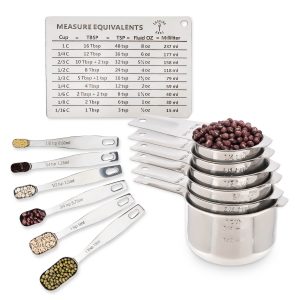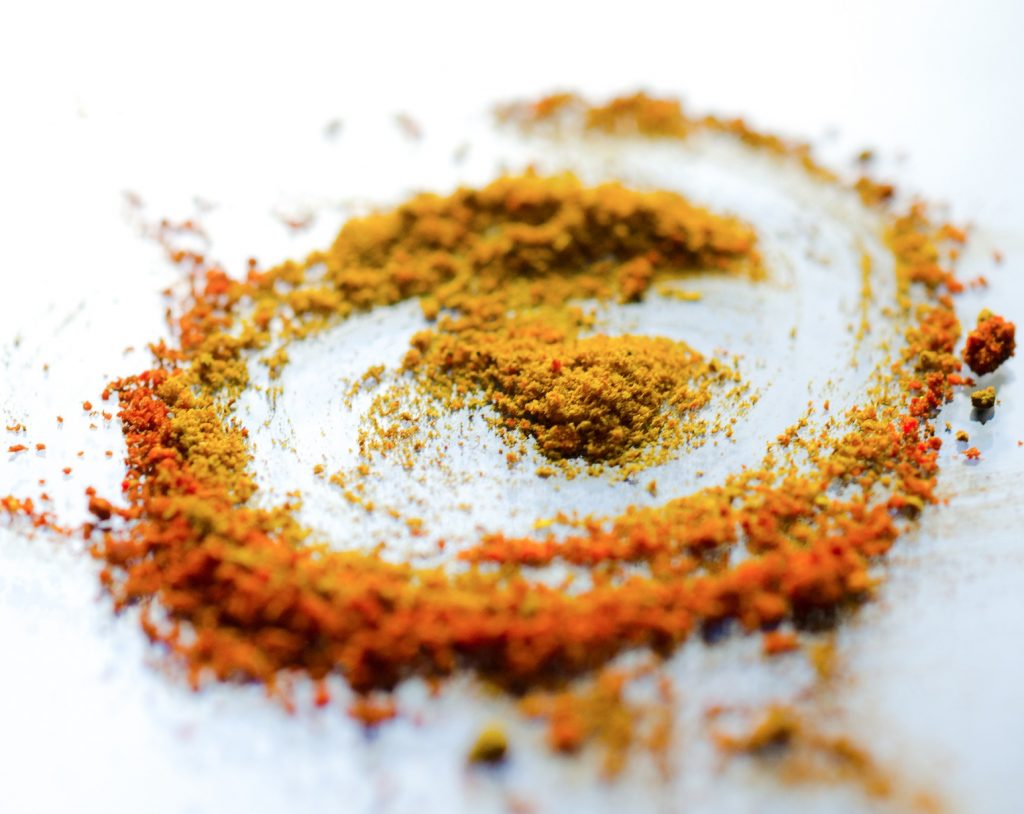[et_pb_section bb_built=”1″][et_pb_row][et_pb_column type=”4_4″][et_pb_text _builder_version=”3.10.2″]
Curry is a way of cooking all throughout S.E. Asia
India, Sri Lanka, Indonesia, Malaysia and Thailand are well known for their curries and each region will have small variations to make it uniquely theirs
This recipe is for the Indian spice blend that is known around the globe.
It is sweet, roasted and spicy in the right proportions – Curries can be fiery or delicate with a complex body.
If you are new to seasoning food with curry spice blend, or want to know more about it download our spice eBook
Get our Spice eBook BELOW to get full instructions on how to use this easy spice blend!
Inside is a recipe for a delicious Lamb and green pea curry
PLUS get 5 other spice blend recipes and instructions
BBQ
Mexican
Lemon Pepper
Cajun
Cuban

Also included in the Ebook :
An amazing discount code to buy our Stainless steel measuring Cups and Spoons – This will ensure accuracy when making your spice mix
The name curry is a derivative from an Indian/Tamil word “Kari” that means sauce.
Curries were originally seasoned with black and white peppercorns instead of chilies and it wasn’t until the late 1400’s that chilies came to India.
Christopher Columbus discovered this spice in Mexico and bought it back to Spain and Portugal where its popularity took off. It was then taken to the rest of the world and now India is the largest producer of chilies for the rest of the world.
A standard Indian curry recipe is usually made with coriander, cumin, turmeric, ginger, cloves and then pepper and chilies are added to give heat if required. In India, families have their own recipes for curry spice blend, as well for Garam Masala. Garam Masala is a spice blend with stronger and sweeter body and is typically found in Northern India.
Curry is used to season soups, meat, eggs and vegetables. It is versatile and lovely with complex notes. Nowadays, this spice still carries many Indian culinary aromas, however with an adaption to the contemporary international culinary
Indian Curry Spice Blend
- 2 tablespoons Cumin powder
- 2 tablespoons white pepper powder
- 2 tablespoons Coriander powder
- ¼ cup Turmeric powder
- 1 teaspoon Ginger powder
- 1 tablespoon Dry mustard
- 1 teaspoon Black pepper powder
- 1 teaspoon Cinnamon powder
- 1/3 teaspoon Cardamom powder
- ½ teaspoon Cayenne pepper
- ½ teaspoon clove powder
- Mix all elements together and use to flavour your food
- Store in a spice jar
For Accurate measurements
A link to the set with a sweet discount is included in the Ebook listed above.

How to store your blends
- Keep away from heat, moisture, and direct sunlight. Avoid storing over the stove, dishwasher, sink or near a window. These elements will reduce flavour intensity and can also introduce moisture to your blend storage containers.
- Always close spice containers tightly after each use.
How to Optimize Freshness
- Spices and herbs that are whole, will maintain their freshness longer than those that are ground.
- Spices and herbs do not spoil as such but they do lose their strength. Old and weak seasonings will not deliver the taste they should.
- Spices and herbs will keep for a long time if they are stored in airtight bottles. The shelf life of properly stored spices and herbs is approximately 4 years for whole spices, 2-3 years for ground spices and 1-3 years for leafy herbs or when using dried peel.
- To see if your spices and herbs are still fresh – Check the look, smell and taste. A visual check for color fading is a good indicator of flavour loss. Taste and smell your spices and herbs; if a fresh odor or taste is not apparent, they need to be replaced.
- Do not sprinkle spices and herbs directly from the bottle over steam. Steam introduced into the bottle will hasten the loss of flavour and aroma. Steam will also result in the spices clumping together.
- Make sure your measuring spoon is completely dry when you dip it into the bottle. Moisture introduced into the bottle will also result in caking and flavour loss.
[/et_pb_text][/et_pb_column][/et_pb_row][/et_pb_section]




The diversity of curry across Southeast Asia truly reflects the rich tapestry of cultural influences in the region. I’ve found that each recipe opens up a new story and experience. For instance, while Indian curries are often celebrated for their robust spices, I love how Thai curries, with their fragrant herbs like lemongrass and kaffir lime, bring a refreshing twist. It’s fascinating how the same core ingredients can transform so dramatically based on regional cooking styles and traditions.
You’ve captured the essence of curries beautifully. The way each region elevates the core ingredients offers not only a unique taste but also a glimpse into their history and culture. When it comes to Indian curries, you’re spot on about the spices; they often tell stories of trade routes and ancient practices. Each spice has its own heritage, layered with tales that go beyond the dish itself. A classic masala might make you think of the northern plains of Punjab, while a coconut curry from Kerala evokes images of palm-fringed backwaters.
“Absolutely! If you’re eager to explore more about the unique flavors and stories behind each curry, check out this link for delicious recipes and cultural insights.”
https://cookinggods.com/ChocolateHealth
I completely agree with you about the incredible diversity of curry across Southeast Asia. Each region not only showcases unique flavors but also embodies its own history and cultural nuances. It’s interesting to think about how the same basic components can evolve so differently depending on the local palate and available ingredients.
You’ve touched on something really vital when it comes to understanding the essence of curry in Southeast Asia. It’s fascinating to consider how the same foundational elements can give rise to such diverse interpretations. At its core, curry might consist of similar spices and ingredients, but when you look closely, each region has its own distinct flair that speaks to local traditions and preferences.
“Absolutely! If you’re curious to explore these unique curry recipes and their fascinating backgrounds, check out this link for a culinary journey through Southeast Asia!”
https://cookinggods.com/DigestiveHealth
Your exploration of curry as a culinary tradition across S.E. Asia really resonates with me! It’s fascinating how each region infuses their unique cultural influences into their versions of curry, creating a tapestry of flavors that tell a story of their heritage.
You nailed it! The way each region plays with curry is like watching artists paint with spices instead of brushes. One area tosses in lemongrass, while another throws in coconut milk like it’s going out of style. And don’t even get me started on the different types of heat—some curries will kiss you softly, while others will send you running for the nearest jug of water like you’re in a spicy triathlon.
Thank you for your thoughtful comment! If you’re intrigued by the diverse flavors and stories behind curry, I invite you to explore more about this vibrant culinary tradition at [insert link].
https://cookinggods.com/SmoothieRecipes
Ah, curry—the spice of life! It’s like a world tour for your taste buds, and each region’s twist feels like a new destination on the culinary map. I remember trying a Sri Lankan curry once that was so fiery, it left me questioning my life choices while simultaneously re-evaluating the boundaries of my spice tolerance!
Curry really does take us on that flavor journey, doesn’t it? Every region has its own unique spin, and trying those variations is like stepping into a different world. Your experience with that Sri Lankan curry sounds intense—nothing like a serious heat check to remind you just how adventurous cooking can be. It’s funny how something as simple as a dish can make us rethink our limits.
Curry really is a fascinating journey, isn’t it? Your experience with that Sri Lankan curry echoes a common theme many face: the moment when a dish challenges not just your palate, but your confidence in handling heat. It’s almost like an initiation rite for spice lovers.
Curry really does have this magical ability to take us on a journey, doesn’t it? Every region adds its own flair, and those twists can seriously redefine what we think of as spicy. That Sri Lankan curry experience you mentioned sounds intense; the balance of heat and flavor from ingredients like roasted spices and coconut can be mind-bending.
You’ve really captured the essence of curry and its ability to transport us. Each region adds its own twist, and it’s fascinating how ingredients and cooking methods vary so much. Take Sri Lankan curry, for example—it’s a whole experience, right? The way roasted spices blend with coconut creates this rich depth that’s hard to resist.
Absolutely! If you’re curious to explore more about the captivating world of curries and their incredible regional variations, check out this link for some delicious recipes and insights!
https://cookinggods.com/ChocolateHealth
Curry really does have this incredible ability to transport you, doesn’t it? Each region’s take can be so different yet equally rich and complex. Your experience with that Sri Lankan curry sounds intense; they really know how to bring the heat! I remember a similar moment with a spicy masala in India that had me questioning my spice threshold too. It’s fascinating how these flavors not only tantalize our taste buds but also connect us to the culture and stories behind them.
Speaking of culinary adventures, I stumbled upon this guide for beginners that simplifies cooking with an Instant Pot—perfect for exploring new flavors without the intimidation factor.
‘Instant Pot Recipes for Beginners: Easy Cooking Made Simple’
https://cookinggods.com/instant-pot-recipes-for-beginners-easy-cooking-made-simple/.
Curry really does have a remarkable way of connecting us to different cultures. It’s like each dish tells a story, filled with the history and traditions of its people. The heat in Sri Lankan curry can be quite the adventure; it pushes your taste buds and makes you appreciate the spices even more.
Your experience with that fiery Sri Lankan curry really resonates. It’s funny how a single dish can feel like a personal challenge while simultaneously opening up a whole world of flavors and experiences. That balance between too spicy and just right is like walking a tightrope—one misstep, and you’re questioning everything, like, “What was I thinking?” But that’s part of the adventure, isn’t it?
“Absolutely! Each curry truly does take you on a flavor adventure. If you’re looking to explore more fiery delights, check out these amazing recipes to elevate your spice journey!”
https://cookinggods.com/KetoBreads
It’s interesting how curry blends differ not just across countries but even within regions of India. Each family seems to have its own recipes passed down through generations, which often reflect personal tastes and regional ingredients. I’ve found that experimenting with different spice ratios can really transform a dish.
You bring up such a wonderful point about the diversity of curry blends, especially within India. It’s fascinating how personal and familial history intertwines with these recipes. I’ve noticed that even small adjustments in spice ratios can create entirely different flavor profiles. For example, in my experience, using a bit more turmeric can add a warmth that really complements richer ingredients, while an extra pinch of cumin can elevate the earthiness of a dish.
You’ve captured a key aspect of Indian cooking—the subtlety that small changes can bring. It’s interesting to think about how generations have perfected their blends, often in response to what’s available or what complements their regional ingredients.
You’ve hit on something really intriguing about Indian cuisine. The idea that each family has its own twist on traditional recipes speaks to a broader narrative of personal connection in cooking. Families don’t just pass down ingredients; they hand down memories, preferences, and the unique strokes of creativity that make those dishes their own. It’s a bit like a musical score—everyone has their variations, and sometimes those small changes can create something completely new and exciting.
Absolutely! The diversity in curry recipes is so fascinating. If you’re looking to elevate your cooking even further, check out some unique spice blends we’ve curated. They might just spark the next great dish in your kitchen!
https://cookinggods.com/KetoBreads
You’re spot on about the differences in curry blends, not just across India but even within smaller communities. It’s fascinating how food really tells a story of culture and personal history. I remember a friend once shared their grandmother’s recipe for a particular dal that was so unique—she used a spice combination that included a hint of jaggery and cinnamon, which I had never encountered before.
It’s fascinating how each region puts its unique stamp on curry, isn’t it? I’ve had the pleasure of tasting Thai green curry and South Indian sambar, and the differences in flavor profiles are so pronounced yet equally delightful. I appreciate how you’ve highlighted the versatility of curry spice blends—it’s such a forgiving way to cook! I find that using these blends can make exploring different cuisines much more accessible, especially for those of us who might feel intimidated by complex recipes. I’m definitely looking forward to trying out the lamb and green pea curry from your eBook! Also, the other spice blends you mentioned sound like a great way to bring a variety of flavors to everyday meals. Have you thought about including tips on how to adjust the spice levels for different palates? It would be interesting to hear everyone’s experiences with adjusting or modifying spice blends to suit their tastes!
It’s true how each region’s unique take on curry can transport you to different culinary worlds. Thai green curry and South Indian sambar really showcase how diverse flavors can tell distinct stories. I remember my first experience with both; the bright, herby notes of the Thai curry contrasted beautifully with the earthy spices in the sambar. It’s fascinating how regional ingredients play a huge role in shaping these flavors.